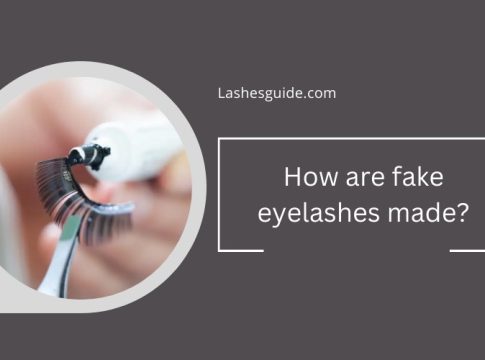Protecting our eyes from debris and enhancing appearance, eyelashes play a crucial role. Luckily, there are ways to enhance or replace lashes, like using false ones. Human lashes, composed of keratin, a durable, flexible, water-resistant protein, are natural. However, crafting them for manufacturing synthetic false lashes is impractical due to scarcity. Synthetic ones prevail due to availability, although some opt for real hair lashes despite their cost and limited availability. Yet, using human hair for fake lashes might not appeal to everyone.
How are fake eyelashes made?
Fake eyelashes typically use synthetic fibers such as nylon, polyester, or silk. The fibers used for the lashes are coated with a special adhesive, then shaped and cut to the desired length and thickness. The manufacturing process typically involves creating a thin strip or individual lashes attached to a small plastic or cotton thread.
Once the lashes are cut and shaped, they are sterilized and packaged for sale. Many different types of false lashes are available, including full-strip lashes, individual lashes, and accent lashes designed to add volume and length to the outer corners of the eyes.
In recent years, technology has advanced to the point where some false eyelashes are now made with more natural-looking fibers and designed to mimic the appearance of real eyelashes. There are also magnetic and adhesive lashes that are easier to apply and remove without glue.
Types of lashes:
Several types of fake eyelashes are available on the market, each with its unique style, material, and application method. Here are some of the most popular types of fake eyelashes:
Mink Lashes:
Mink lashes are made from the fur of minks, which are small animals that belong to the weasel family. They are known for their natural, wispy look and soft texture. Mink lashes are lightweight, durable, and comfortable to wear. However, they are more expensive than synthetic lashes, and some people prefer not to use them due to ethical concerns.
Synthetic Lashes:
Crafted from materials like nylon, polyester, or silk, synthetic lashes offer affordability, wide accessibility, and diverse variations in length, thickness, and style. While they can emulate a natural look, synthetic lashes tend to be denser and more consistent than their natural counterparts. Ideal for individuals seeking to explore various lash styles affordably, they’re a favored choice among budget-conscious enthusiasts. Embraced by vegans and individuals opting out of animal-derived products, synthetic lashes provide a cruelty-free alternative.
Strip Lashes:
Strip lashes are available in various lengths, thicknesses, and styles, from natural-looking to dramatic and glamorous. They are usually made from synthetic materials and applied using lash adhesive along the line. Strip lashes can be reused multiple times with proper care and maintenance.
Individual Lashes:
Individual lashes are ideal for those who want a more natural look or need to fill in gaps in sparse lashes. They come in different lengths and thicknesses, allowing you to customize the look to your desired level of fullness. Individual lashes are applied using lash adhesive and can last up to several weeks before needing a touch-up.
Accent Lashes:
Accent lashes are a great way to enhance the shape of the eyes and add volume and length to the outer corners. They are usually shorter than strip lashes and can be applied individually or in small clusters. Accent lashes can be combined with strip or individual lashes for a more customized look.
Magnetic Lashes:
Magnetic lashes represent an innovative form of false eyelashes employing small magnets for attachment to your natural lashes. Ideal for individuals with sensitive eyes or adhesive allergies, these lashes are available in strip or individual styles and boast reusability across multiple uses.
Adhesive Lashes:
Adhesive lashes are available in both strip and individual lash styles, and use special glue to attach the false lashes to the natural lashes. They come in different formulas, including latex-free, waterproof, and clear, allowing you to choose the one that best suits your needs. Adhesive lashes can last up to several weeks before needing a touch-up.
Pre-glued Lashes:
Pre-glued lashes come with adhesive already applied to them, making them easy to apply without additional glue. They are available in both strip and individual lash styles and are a great option for those new to false lashes or in a hurry.
Human Hair Lashes:
Human hair lashes are made from real human hair and are designed to look more natural than synthetic lashes. They are soft, lightweight, and can be curled and styled like natural lashes. Human hair lashes are a great option for those who want a more natural look and feel from their false lashes.
FAQS:
Q1: Can you sleep with fake eyelashes on?
A: Although it is possible to sleep with fake eyelashes, it is not recommended due to potential damage to both the false and natural lashes. Sleeping with false lashes can cause strain on the natural lashes, leading to weakness and brittleness over time.
Q2: How do you remove false eyelashes?
A: Gently peel off the lash strip starting from the outer corner of the eye and working your way inwards. If the lashes are individual, use an oil-based makeup remover on a cotton swab to dissolve the adhesive and gently pull the lash out. Never pull or tug at the lashes, as this can damage your natural lashes.
Conclusion:
Fake eyelashes come in various materials like mink, synthetic fibers, and even human hair. They’re crafted by shaping these fibers into different styles and sizes, then securing them onto strips or individual lash bases before packaging for sale. Your choice of false lashes often revolves around your preferred style, budget, and personal taste. To preserve your natural lashes, handle and remove faux lashes delicately. When cared for properly, they don’t just enhance your beauty but also boost your self-assurance for whatever the world brings your way.

